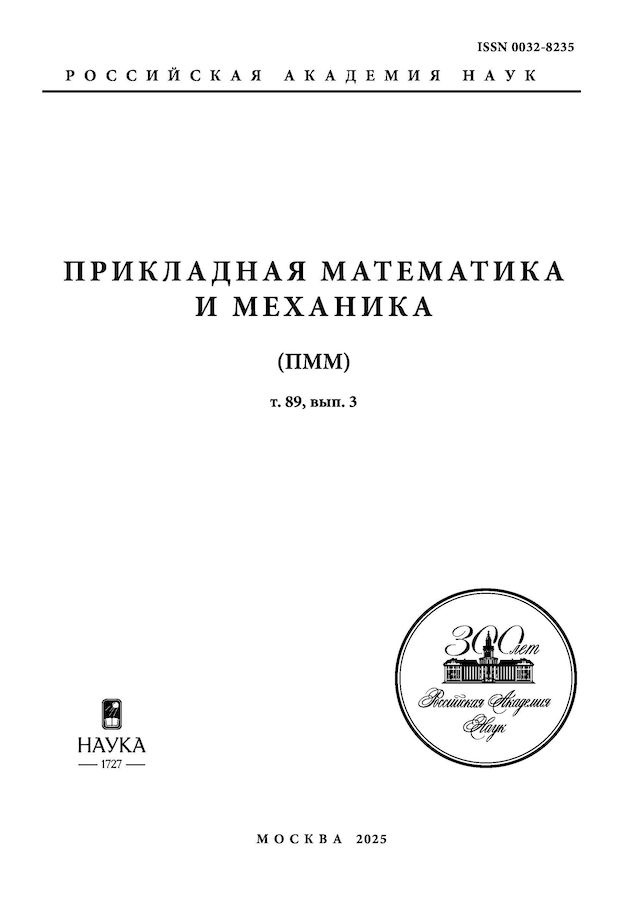Models of discrete contact of elastic bodies taking into account adhesion forces
- Authors: Goryacheva I.G.1, Makhovskaya Y.Y.1, Tsukanov I.Y.1
-
Affiliations:
- Ishlinsky Institute for Problems in Mechanics of the RAS
- Issue: Vol 89, No 3 (2025)
- Pages: 512-528
- Section: Articles
- URL: https://jdigitaldiagnostics.com/0032-8235/article/view/688827
- DOI: https://doi.org/10.31857/S0032823525030115
- EDN: https://elibrary.ru/JLVXEK
- ID: 688827
Cite item
Abstract
The paper presents formulations and solutions of periodic contact problems for an elastic half-plane and an elastic half-space taking into account the adhesive interaction of contacting bodies’ surfaces. To describe the adhesive forces in the gap between the surfaces, an approximation of the adhesive potential in the form of a piecewise constant function (the Maugis–Dugdale approximation) is used. The dependences of the real contact area, as well as the approach of bodies on the nominal pressure, the parameters of adhesive potential, and the surface relief parameters of the indenting body are investigated. The obtained solutions are compared with the results following from the Johnson, Kendall, Roberts (JKR) model based on the use of a simplified form of the adhesive potential. An analysis of energy dissipation in the surfaces approach–retraction cycle is carried out, and the influence of the parameters of surface microrelief on this contact interaction characteristic is estimated.
Keywords
Full Text
About the authors
I. G. Goryacheva
Ishlinsky Institute for Problems in Mechanics of the RAS
Author for correspondence.
Email: goryache@ipmnet.ru
Russian Federation, Moscow
Yu. Y. Makhovskaya
Ishlinsky Institute for Problems in Mechanics of the RAS
Email: makhovskaya@mail.ru
Russian Federation, Moscow
I. Y. Tsukanov
Ishlinsky Institute for Problems in Mechanics of the RAS
Email: ivan.yu.tsukanov@gmail.com
Russian Federation, Moscow
References
- Johnson K.L., Kendall K., Roberts A.D. Surface energy and the contact of elastic solids // Proc. Roy. Soc. London A, 1971, vol. 324, pp. 301–313.
- Johnson K.L., Greenwood J.A. An adhesion map for the contact of elastic spheres // J. Coll.&Interface. Sci., 1997, vol. 192, pp. 326–333.
- Tabor D. Surface forces and surface interactions // J. Coll.&Interface. Sci., 1977, vol. 58, no. 2, pp. 13.
- Derjaguin B.V., Muller V.M., Toporov Yu.P. Effect of contact deformation on the adhesion of particles // J. Coll.&Interface Sci., 1975, vol. 53, no. 2, pp. 314–326.
- Goryacheva I.G. Mechanics of Frictional Interaction. Moscow: Nauka, 2001. 478 p. (in Russian)
- Johnson K.L. The adhesion of two elastic bodies with slightly wavy surfaces // lnt. J. Solids& Struct., 1995, vol. 32, no. 3/4, pp. 423–430.
- Westergaard H.M. Bearing pressures and cracks // J. Appl. Mech. T. ASME, 1939, vol. 6, pp. 49–52.
- Koiter W. An infinite row of collinear cracks in an infinite elastic sheet // Ingng Arch., 1959, vol. 28, pp. 168–172.
- Hui C.Y., Lin Y.Y., Baney J.M., Kramer E.J. The mechanics of contact and adhesion of periodically rough surfaces // J. Polym. Sci., Pt. B: Polym. Phys., 2001, vol. 39, no. 11, pp. 1195–1214.
- Maugis D. Adhesion of spheres: The JKR-DMT transition using a Dugdale model // J. Coll.&Interface Sci., 1991, vol. 150, pp. 243–269.
- Johnson K.L. Contact Mechanics. Cambridge: Univ. Press, 1985. XII+452 p.
- Makhovskaya Y.Y. The sliding of viscoelastic bodies when there is adhesion // JAMM, 2005, vol. 69, no. 2, pp. 305–314.
- Tsukanov I.Yu. Thermoelastic instability when heterogeneous materials with different properties sliding over a rigid surface // Rus. Engng. Res., 2022, vol. 42, no. 1, pp. 44–48.
- Kuznetsov Ye.A. Effect of fluid lubricant on the contact characteristics of rough elastic bodies in compression // Wear, 1985, vol. 102, pp. 177–194.
- Greenwood J.A. On the almost-complete contact of elastic rough surfaces: The removal of tensile patches // Int. J. Solids Struct., 2015, vol. 56–57, pp. 258–264.
- Maugis D. Contact, Adhesion and Rupture of Elastic Solids. 2000. 414 p.
- Goryacheva I G., Makhovskaya Y.Y. Adhesive interaction of elastic bodies // JAMM, 2001, vol. 65, no. 2, pp. 273–282.
- Goryacheva I., Makhovskaya Y. Discrete Contact Mechanics with Applications in Tribology. Elsevier Inc., 2022. 220 p.
- Makhovskaya Yu.Yu. Discrete contact of elastic bodies in the presence of adhesion // Mech. Solids, 2003, vol. 38, no. 2, pp. 39–48.
- Goryacheva I., Makhovskaya Yu. A model of the adhesive component of the sliding friction force // Wear, 2011, vol. 270, pp. 628–633.
- Soldatenkov I.A. The use of the method of successive approximations to calculate an elastic contact in the presence of molecular adhesion // JAMM, 2012, vol. 76, no. 5, pp. 597–603.
- Soldatenkov I.A. Contact Problem with bulk-applied intermolecular interaction forces: a simplified solution method (two-level model) // Mech. Solids, 2019, vol. 54, no. 2, pp. 303–310.
- Muller V.M., Yushchenko V.S., Derjaguin B.V. On the influence of molecular forces on the deformation of an elastic sphere and its sticking to a rigid plane // J. Coll.&Interface Sci., 1980, vol. 77, no. 1, pp. 91–101.
- Goryacheva I., Makhovskaya Yu. A model of the adhesive component of the sliding friction force // Wear, 2011, vol. 270, pp. 628–633.
- Goryacheva I.G., Makhovskaya Y.Y. Adhesive resistance in the rolling of elastic bodies // JAMM, 2007, vol. 71, no. 4, pp. 485–493.
Supplementary files

















